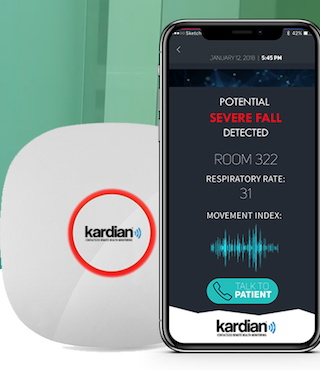 It looks like a simple fire alarm, but instead of detecting smoke the Kardian Contactless Health Monitoring System is designed to detect falls.
It looks like a simple fire alarm, but instead of detecting smoke the Kardian Contactless Health Monitoring System is designed to detect falls.
The wireless system uses impulse radio ultra-wideband radar technology and can scan a room one million times per second. The system scans for slips and falls, including sliding falls, and also for when someone sits up quickly, which could alert hospital staff that a patient is about to get out of bed.
Kardian claims that the system can detect a slip with 99 percent accuracy. The system also has a personal emergency response system to alert caregivers if someone has fallen.
Outside of detecting falls, the technology can monitor resting heart rate, breathing rate, and sleep apnea. The company said it can detect health risks like heart arrhythmia and prolonged deterioation of the sleep cycle as well.
Kardian said the system, which is set to debut next week at HIMSS 2018, was in the making for the last half a dozen years. Cofounder and CTO Dr. James Sung Ho Cho started developing the product in 2012, but the first renditions cost over $15,000. Eventually he started collaborating with doctors and engineers on what is the South Korean-based startup’s first product to launch.
The monitoring system is only available in hospitals and senior care facilities, according to the website, however the company said that the system could eventually work in homes as well.
Falling is a major health risk. The World Health Organization reports that there are 37.3 million each year that are severe enough to require medical attention. Around 646,000 people die from falls across the world each year, according to WHO.
Recently several wearable companies have developed fall alert and prevention systems. Notably, ActiveProtective recently released a wearable fall-sensing airbag, which people at risk of a fall can wear around their hips like a belt.
Perhaps a more traditional monitor to note is CarePredict’s LifeWell Senior Living System, which tracks patients movements through a wearable wristband. The system aims to track users behaviors and alerts caretakers of potential declines or emergencies.














